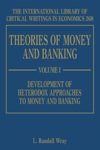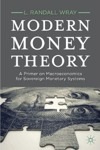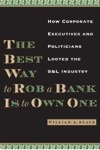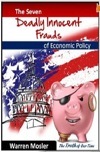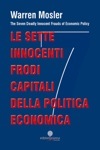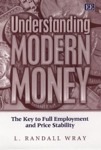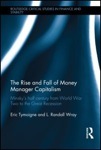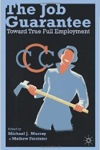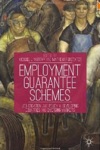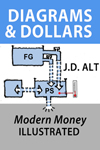By William K. Black
(via the Huffington Post)
President Obama’s Executive Order on regulatory review was originally set in motion by his February 3, 2009 direction to OMB to create an improved regulatory review process.
The fundamental principles and structures governing contemporary regulatory review were set out in Executive Order 12866 of September 30, 1993. A great deal has been learned since that time. Far more is now known about regulation — not only about when it is justified, but also about what works and what does not. Far more is also known about the uses of a variety of regulatory tools such as warnings, disclosure requirements, public education, and economic incentives. Years of experience have also provided lessons about how to improve the process of regulatory review. In this time of fundamental transformation, that process–and the principles governing regulation in general — should be revisited.
September 30, 1993 is an interesting date. I was the deputy director of the National Commission on Financial Institution Reform, Recovery and Enforcement (NCFIRRE). We issued our report in July 1993 on the causes of the S&L debacle. Our report was based on an extensive investigation of what worked and what failed in regulation.
In particular, we found that the deregulation and desupervision created an environment in which at “the typical large failure” “fraud” was “invariably present.” By fall 1993, the Office of Thrift Supervision had learned the lessons and developed extremely effective rules, supervision, enforcement, and support for the criminal justice system. Congress passed the Prompt Corrective Action (PCA) law in 1991. The regulators had removed the abusive regulatory accounting rules designed to cover up the scale of the debacle. Administration officials had falsely used this cover up of losses through accounting gimmickry to claim that the S&L crisis had been “resolved” at no cost to the taxpayers. The PCA was based on the finding that such accounting cover ups and “forbearance” greatly increased the eventual cost to the taxpayers.
By fall 1993, a well-functioning partnership of the OTS and the Justice Department had produced over 1,000 felony convictions of “major” S&L frauds — it remains to this day the greatest success against elite criminals in history. The Justice Department and the OTS ensured that the prosecutions were prioritized properly by creating the “Top 100” list. The OTS (which was created in 1989) had brought over 1,000 serious enforcement actions. The OTS secured over $1 billion in settlements from top tier auditors and brought hundreds of successful civil actions against the elite frauds. The reregulatory effort was so successful that for the next 15 years every U.S. Treasury Secretary flew to Tokyo and urged Japan’s leaders to stop relying on dishonest accounting to cover up their main banks’ losses and to instead adopt the regulatory policies that prevented the S&L debacle from becoming a catastrophe.
By September 1993, the S&L regulators had written extensively of our research findings about the role of accounting control fraud in driving the crisis and the regulatory and accounting lessons we had learned. My papers, collectively roughly 500 pages, had been circulated among many finance economists. Our work explained why econometric studies produced exceptionally erroneous findings in the presence of accounting control fraud and financial bubbles. Three of the nation’s leading white-collar criminologists, Henry Pontell, Kitty Calavita, and Robert Tillman had published several journal articles on these same topics. George Akerlof and Paul Romer formally presented their paper on accounting control fraud — “Looting: the Economic Underworld of Bankruptcy for Profit” at the Brookings Conference on September 9, 1993 before many of the nation’s most prominent finance specialists.
The NCFIRRE report notes that key elements of the Reagan administration — particularly Treasury and OMB, actively opposed our vital reregulation of the S&L industry. That reregulation was essential to containing a raging epidemic of accounting control fraud in the mid-1980s. Only the fact that the Federal Home Loan Bank Board was an independent regulatory agency prevented OMB from blocking S&L reregulation.
President Obama is correct that white-collar criminologists and a few non-theoclassical economists have continued to add to the useful understanding of regulation since 1993. However, his 2009 direction to OMB is not candid. By September 1993, we not only knew how to regulate effectively — financial regulation was exceptionally effective — and employment and growth were surging. The perverse (Gresham’s) dynamics that the accounting control frauds had caused that destroyed wealth and jobs had been eliminated or minimized. Even the most elite frauds and their elite political allies were held accountable. Bank Board Chairman Gray led the successful reregulation in late 1983-mid-1987 over the intense opposition of the Reagan administration, a majority of the House of Representatives, Speaker Wright, and the five U.S. Senators that became known as the “Keating Five.” Paul Volcker was Gray’s sole powerful ally. Wright and the Keating Five intervened on behalf of the two worst control frauds in America. S&L regulators had their careers destroyed, but continued to buck the frauds and their political patrons and do their duty to the public.
In 1991-1992, the OTS’ West Region used its supervisory powers to squash a fast-developing trend among a number of California S&Ls to make “liar’s” loans. We recognized that such loans were inherently unsafe and unsound and frequently fraudulent. Our efforts were so effective that Long Beach Savings gave up its federal charter to escape our regulatory authority. It became a mortgage banker and rebranded itself as Ameriquest — the most notorious of the early non-federally regulated lenders specializing fraudulent and predatory nonprime loans.
What happened after September 1993 is that OMB and Treasury, in alliance with Fed Chairman Greenspan and Senator Gramm, lost the accurate understanding of why vigorous financial regulation is essential and how one makes regulation effective. OMB, Treasury, Greenspan, and Gramm adopted anti-regulatory policies that were intensely criminogenic. We had to reregulate without the benefits of the criminology studies by Pontell, Calavita and Tillman and Akerlof & Romer’s economic studies. The Clinton and Bush administrations had the advantage of all our research and our demonstration of which financial regulatory policies succeed and which fail. (They also had the benefit of the public administration scholars’ books and articles that studied used our reregulation and concluded that it was an exemplar of effective regulation.) Unfortunately, the “completely failed” economic dogma that the Clinton and Bush administrations, Greenspan and Bernanke, and Senator Gramm shared led them to ignore our successes and adopt anti-regulatory policies that were so perverse that they were intensely criminogenic.
The recent epidemics of accounting control fraud, the creation of the largest bubble in history, and the Great Recession could not have occurred if the Clinton and Bush administrations had actually learned a great deal about what works and what fails in regulation. The Clinton and Bush anti-regulatory policies created the “three des” — deregulation, desupervision, and de facto decriminalization. In late 2008, however, then-Senator Obama proclaimed that he had learned the correct regulatory “lessons” from the resulting economic collapse. From the Washington Post:
“John McCain has spent decades in Washington supporting financial institutions instead of their customers,” [Obama] told a crowd of about 2,100 at the Colorado School of Mines. “So let’s be clear: What we’ve seen the last few days is nothing less than the final verdict on an economic philosophy that has completely failed.”
Senator Obama was correct — the Clinton and Bush anti-regulatory policies were a catastrophic failure that permitted the epidemics of fraud that drove the Great Recession and the loss of over 10 million jobs. OMB was among the most virulent opponents of vigorous financial regulation because it has long been dominated by anti-regulatory economists embracing the “economic philosophy that has completely failed.” Bush selected financial regulatory leaders on the basis of the strength of their anti-regulatory zeal. President Obama was incorrect, therefore, in his February 3, 2009 directive to the OMB about the improved understanding of regulation. “Years of experience” have not taught the theoclassical economists “far more” “about what works and what does not” in regulation. The theoclassical economists know vastly less about effective regulation now than did OTS in 1993.
The University of Chicago economists that President Obama appointed to senior positions related to regulatory policy scorned financial regulation. Austan Goolsbee, now Chairman of the President’s Council of Economic Advisors poured scorn on those who warned of the urgent need to regulate nonprime loans. In a March 29, 2007 op-ed in the New York Times, Goolsbee derided those warning that nonprime loans were a “time bomb.”
This column shows why the reasoning and methodology that Goolsbee employed “completely failed” because it relied on anti-regulatory dogma rather than sound economics and white-collar criminology. The column also shows that Obama’s regulatory review policy embraces Goolsbee’s “completely failed” anti-regulatory dogma and methodology and ignores the sound findings and methodologies employed by successful regulators, economists, and white-collar criminologists. Obama is correct that white-collar criminologists and non-theoclassical economists have learned “far more” “about what works and what does not” in regulation. He is incorrect that his economic team has learned these “lessons.”
Goolsbee loves financial innovation and “consumer choice.” He began his defense of nonprime loans by decrying the “very old vein of suspicion against innovations in the mortgage market.” Goolsbee premised his argument upon the findings of an econometric study of home lending innovations. He argued:
These innovations mainly served to give people power to make their own decisions about housing, and they ended up being quite sensible with their newfound access to capital.
[T]he mortgage market has become more perfect, not more irresponsible. People tend to make good decisions about their own economic prospects.
Of course, basing loans on future earnings expectations is riskier than lending money to prime borrowers at 30-year fixed interest rates. That is why interest rates are higher for subprime borrowers and for big mortgages that require little money down. Sometimes the risks flop. Sometimes people even have to sell their properties because they cannot make the numbers work.
And do not forget that the vast majority of even subprime borrowers have been making their payments. Indeed, fewer than 15 percent of borrowers in this most risky group have even been delinquent on a payment, much less defaulted.
When contemplating ways to prevent excessive mortgages for the 13 percent of subprime borrowers whose loans go sour, regulators must be careful that they do not wreck the ability of the other 87 percent to obtain mortgages.
For be it ever so humble, there really is no place like home, even if it does come with a balloon payment mortgage.
It’s hard to get something more wrong than Goolsbee (and the economists that conducted the study he relied upon) got this wrong. Theoclassical economics assumes that market participants are rational, informed, and utility-maximizing. It follows that expanding choices is always the correct policy. Some individuals who find the new option desirable will take it and be better off. Individuals that can expect to be worse off if they select a new option will not select it. Anyone who criticizes relying on consumer choice is paternalistic and is demeaning less-affluent consumers’ decision-making skills. The econometric study he relies and topic he discusses are perfect foils to illustrate Goolsbee’s opposition to regulation.
The problem is that the study Goolsbee relied upon illustrates why fraud makes econometric studies fail. I have explained (and these explanations can be found in my 1993 NCFIRRE papers and Akerlof & Romer’s 1993 article) why accounting control fraud epidemics can hyper-inflate financial bubbles. Bubbles allow accounting control frauds to refinance bad loans and delay delinquencies and defaults. The regional real estate bubbles had begun bursting before Goolsbee wrote his op-ed — the delinquencies, defaults, and foreclosures lag the collapse of the bubble. A 13% delinquency rate would kill most subprime lenders, but the eventual default rate was likely to be far higher. Goolsbee ignores the loss to the consumer of purchasing a home with substantial negative equity.
Goolsbee stresses that many of the subprime borrowers are relatively poorer minorities. The predatory lenders that induced them to take out loans they could not repay created reverse Pareto optimality — both parties to the nonprime loans made in 2006 and 2007 typically suffered a serious financial loss. Nonprime loans in 2003-2007 hyper-inflated the bubble and the markets increasingly less efficient (not ever more “perfect”). When one considers the endemic mortgage fraud by lenders and their agents and resultant negative expected value of the transaction we see that the frauds also cause negative externalities to the public. The nonprime borrowers included some speculators, but the typical borrower was the prey and the typical nonprime borrower lost wealth.
The three key elements that Goolsbee relied upon to give the worst possible policy advice on how regulators should respond to the nonprime loans (do nothing, all is well, the lenders are making the nonprime borrowers friends) are (1) a presumption that financial innovation is good and that financial regulation is bad if it reduces innovation, (2) greater consumer choice is good and financial regulation is bad if it reduces choice (note the innovation increases choice), and (3) the scientific means of choosing between alternative regulatory policies is to rely on econometric studies. Obama’s Executive Order revising regulatory review policy enshrines each of these three elements even though Goolsbee demonstrated that they lead to the most destructive regulatory policies if control fraud or bubbles are present. Obama’s Wall Street Journal letter adopted this Republican talking point about “innovation.”
Sometimes, those rules have gotten out of balance, placing unreasonable burdens on business–burdens that have stifled innovation and have had a chilling effect on growth and jobs.
There are doubtless some contexts where this unsupported assertion could be true, e.g., the various bans on stem cell research, but in the financial context “innovation” frequently poses systemic risks, is devoid of social utility, and has no demonstrated advantage to anyone but the seller. Paul Volcker has made this point forcefully:
I hear about these wonderful innovations in the financial markets, and they sure as hell need a lot of innovation. I can tell you of two — credit-default swaps and collateralized debt obligations — which took us right to the brink of disaster. Were they wonderful innovations that we want to create more of?
You want boards of directors to be informed about all of these innovative new products and to understand them, but I do not know what boards of directors you are talking about. I have been on boards of directors, and the chance that they are going to understand these products that you are dishing out, or that you are going to want to explain it to them, quite frankly, is nil.
I mean: Wake up, gentlemen. I can only say that your response is inadequate. I wish that somebody would give me some shred of neutral evidence about the relationship between financial innovation recently and the growth of the economy, just one shred of information.
President Obama’s Wall Street Journal letter directed regulators not to interfere with consumer choice.
[C]reating a 21st-century regulatory system … means using disclosure as a tool to inform consumers of their choices, rather than restricting those choices.
We tried this “economic philosophy” and it “completely failed.” Goolsbee’s op-ed was typical of theoclassical dogma: regulations that restrict consumer choice are inherent illegitimate. The predatory lender pushing the loan that the borrower cannot repay is the borrower’s true friend. The regulator is the paternalistic bureaucrat. The FDIC tried to use disclosure plus consumer education to make this anti-regulatory dogma sound more attractive — and disclosure and consumer education failed to protect the nonprime borrowers.
Obama’s directive is a radical, dangerous assault on regulation and consumers. It would require us to get rid of “suitability” requirements — your 85 year old grandmother’s financial advisor could hand her a “disclosure” page explaining the risks investing in the mezzanine tranche of CDOs and proceed to advise her to put her entire savings in the CDOs. We could not ban “liar’s” loans.
We would have to get rid of many of the food and drug safety laws. We cannot “restrict” the consumer’s “choices.” The drug companies can hand out a “disclosure” page about the risks of a drug that has not been FDA approved for safety and efficacy and it’s up to you to decide whether to buy it. We cannot restrict the consumer’s “choice” so there cannot be any limits on usury or default fees. Your friendly payday lender can hand you their disclosure sheet and then when you are delinquent on a $50 loan they can charge you a $500 fee. We cannot restrict choice, so everybody you contract with can take away your right to sue for torts they commit by disclosing that they have a mandatory arbitration clause and you agree that their maximum liability is $10. Under this logic we couldn’t make prostitution unlawful.
The OMB Director (implicitly) explained the import of the new regulatory review standard for econometrics: “Regulations must be guided by objective scientific evidence.” OMB decides whether the rules are guided by “objective scientific evidence.” OMB is dominated by neoclassical economists who believe, in the economic context, that only econometric studies are “objective scientific evidence.” Econometric studies, however, will show that accounting control frauds are reporting record income in the short-term and that whatever asset is used in the frauds has a strong, positive relationship with income. The regulators could not provide the necessary econometric studies to, for example, stop liar’s loans until the true “sign” (negative) of the relationship between making liar’s loans and income emerged — after the fraud and the bubble collapse. Any proposed rule that would restrict the nonprime lenders’ use of liar’s loans would be contradicted by the “objective scientific evidence” (the econometric study).
The administration is adopting the “completely failed” economic philosophies that rendered regulation ineffective and allowed the epidemics of accounting control fraud that caused the Great Recession. Senator Obama knew that it was imperative that we junk that failed philosophy. President Obama is adopting key aspects of the completely failed philosophy that he condemned. Bring back Senator Obama.


